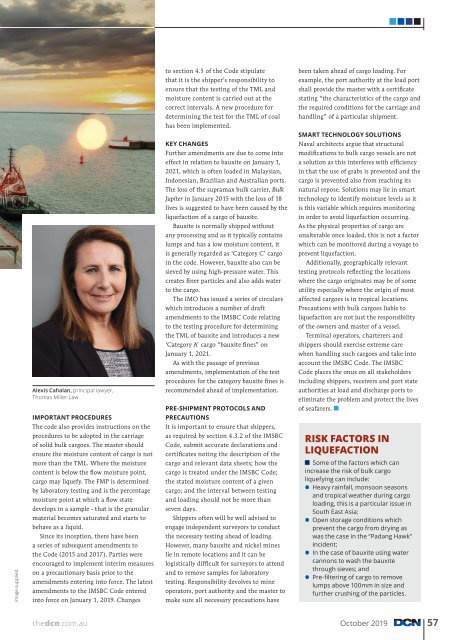DCN October Edition 2019
Create successful ePaper yourself
Turn your PDF publications into a flip-book with our unique Google optimized e-Paper software.
Image supplied<br />
Alexis Cahalan, principal lawyer,<br />
Thomas Miller Law<br />
IMPORTANT PROCEDURES<br />
The code also provides instructions on the<br />
procedures to be adopted in the carriage<br />
of solid bulk cargoes. The master should<br />
ensure the moisture content of cargo is not<br />
more than the TML. Where the moisture<br />
content is below the flow moisture point,<br />
cargo may liquefy. The FMP is determined<br />
by laboratory testing and is the percentage<br />
moisture point at which a flow state<br />
develops in a sample - that is the granular<br />
material becomes saturated and starts to<br />
behave as a liquid.<br />
Since its inception, there have been<br />
a series of subsequent amendments to<br />
the Code (2015 and 2017). Parties were<br />
encouraged to implement interim measures<br />
on a precautionary basis prior to the<br />
amendments entering into force. The latest<br />
amendments to the IMSBC Code entered<br />
into force on January 1, <strong>2019</strong>. Changes<br />
to section 4.5 of the Code stipulate<br />
that it is the shipper’s responsibility to<br />
ensure that the testing of the TML and<br />
moisture content is carried out at the<br />
correct intervals. A new procedure for<br />
determining the test for the TML of coal<br />
has been implemented.<br />
KEY CHANGES<br />
Further amendments are due to come into<br />
effect in relation to bauxite on January 1,<br />
2021, which is often loaded in Malaysian,<br />
Indonesian, Brazilian and Australian ports.<br />
The loss of the supramax bulk carrier, Bulk<br />
Jupiter in January 2015 with the loss of 18<br />
lives is suggested to have been caused by the<br />
liquefaction of a cargo of bauxite.<br />
Bauxite is normally shipped without<br />
any processing and as it typically contains<br />
lumps and has a low moisture content, it<br />
is generally regarded as ‘Category C’ cargo<br />
in the code. However, bauxite also can be<br />
sieved by using high-pressure water. This<br />
creates finer particles and also adds water<br />
to the cargo.<br />
The IMO has issued a series of circulars<br />
which introduces a number of draft<br />
amendments to the IMSBC Code relating<br />
to the testing procedure for determining<br />
the TML of bauxite and introduces a new<br />
‘Category A’ cargo “bauxite fines” on<br />
January 1, 2021.<br />
As with the passage of previous<br />
amendments, implementation of the test<br />
procedures for the category bauxite fines is<br />
recommended ahead of implementation.<br />
PRE-SHIPMENT PROTOCOLS AND<br />
PRECAUTIONS<br />
It is important to ensure that shippers,<br />
as required by section 4.3.2 of the IMSBC<br />
Code, submit accurate declarations and<br />
certificates noting the description of the<br />
cargo and relevant data sheets; how the<br />
cargo is treated under the IMSBC Code;<br />
the stated moisture content of a given<br />
cargo; and the interval between testing<br />
and loading should not be more than<br />
seven days.<br />
Shippers often will be well advised to<br />
engage independent surveyors to conduct<br />
the necessary testing ahead of loading.<br />
However, many bauxite and nickel mines<br />
lie in remote locations and it can be<br />
logistically difficult for surveyors to attend<br />
and to remove samples for laboratory<br />
testing. Responsibility devolves to mine<br />
operators, port authority and the master to<br />
make sure all necessary precautions have<br />
been taken ahead of cargo loading. For<br />
example, the port authority at the load port<br />
shall provide the master with a certificate<br />
stating “the characteristics of the cargo and<br />
the required conditions for the carriage and<br />
handling” of a particular shipment.<br />
SMART TECHNOLOGY SOLUTIONS<br />
Naval architects argue that structural<br />
modifications to bulk cargo vessels are not<br />
a solution as this interferes with efficiency<br />
in that the use of grabs is prevented and the<br />
cargo is prevented also from reaching its<br />
natural repose. Solutions may lie in smart<br />
technology to identify moisture levels as it<br />
is this variable which requires monitoring<br />
in order to avoid liquefaction occurring.<br />
As the physical properties of cargo are<br />
unalterable once loaded, this is not a factor<br />
which can be monitored during a voyage to<br />
prevent liquefaction.<br />
Additionally, geographically relevant<br />
testing protocols reflecting the locations<br />
where the cargo originates may be of some<br />
utility especially where the origin of most<br />
affected cargoes is in tropical locations.<br />
Precautions with bulk cargoes liable to<br />
liquefaction are not just the responsibility<br />
of the owners and master of a vessel.<br />
Terminal operators, charterers and<br />
shippers should exercise extreme care<br />
when handling such cargoes and take into<br />
account the IMSBC Code. The IMSBC<br />
Code places the onus on all stakeholders<br />
including shippers, receivers and port state<br />
authorities at load and discharge ports to<br />
eliminate the problem and protect the lives<br />
of seafarers.<br />
RISK FACTORS IN<br />
LIQUEFACTION<br />
Some of the factors which can<br />
increase the risk of bulk cargo<br />
liquefying can include:<br />
• Heavy rainfall, monsoon seasons<br />
and tropical weather during cargo<br />
loading, this is a particular issue in<br />
South East Asia;<br />
• Open storage conditions which<br />
prevent the cargo from drying as<br />
was the case in the “Padang Hawk”<br />
incident;<br />
• In the case of bauxite using water<br />
cannons to wash the bauxite<br />
through sieves; and<br />
• Pre-filtering of cargo to remove<br />
lumps above 100mm in size and<br />
further crushing of the particles.<br />
thedcn.com.au <strong>October</strong> <strong>2019</strong> 57
















